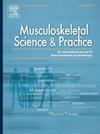有和无运动恐惧症的老年人体位稳定性的边界时间分析。
IF 2.2
3区 医学
Q1 REHABILITATION
引用次数: 0
摘要
背景:老年人运动恐惧症可影响体位稳定性,但有关敏感测量和功能活动的文献仍不一致。目的:研究有和无运动恐惧症的老年人在考虑基于Timed Up and Go (TUG)测试的功能活动时,标准化稳定时间(TIB)阈值测量的差异。研究设计:横断面设计的观察性可行性研究。方法:35名老年运动恐惧症患者和38名对照者分别在睁眼和闭眼条件下完成平台上的优势肢体站立任务。主要终点是TIB,即受试者压力中心(COP)保持在预定径向阈值(距离COP平均位置10 mm-30 mm)内的时间比例。通过计算前后位(AP)和中外侧(ML)尺寸来评估姿势稳定性。结果:在视觉条件(F = 64.28, p = 0.001)和阈值(F = 295.16, p = 0.001)以及视觉条件与阈值的交互作用(F = 18.05, p = 0.001)上存在显著差异。作为协变量的TUG检验结果显示,归一化稳定时间的阈值(F = 16.35, p = 0.001)和视觉条件x阈值(F = 4.36, p = 0.04)之间存在显著的相互作用。结论:视觉输入和较小的COP阈值(本文章由计算机程序翻译,如有差异,请以英文原文为准。
A time-in-boundary analysis on postural stability between older adults with and without kinesiophobia
Background
Kinesiophobia in older adults can affect postural stability, though literature on sensitive measurements and functional mobility remains inconsistent.
Objective
To investigate differences in normalized stability times, measured by various Time-in-Boundary (TIB) thresholds, when considering functional mobility based on the Timed Up and Go (TUG) test between older adults with and without kinesiophobia.
Study design
Observational feasibility study of a cross-sectional design.
Methods
Thirty-five older adults with kinesiophobia and 38 control subjects completed the dominant limb standing task on a platform in eyes-open and eyes-closed conditions. The primary outcome was TIB, which is the proportion of time a subject's center of pressure (COP) stays within predefined radial thresholds (10 mm–30 mm) from the average COP position. This was calculated across anteroposterior (AP) and mediolateral (ML) dimensions to assess postural stability.
Results
There were significant differences in visual conditions (F = 64.28, p = 0.001) and thresholds (F = 295.16, p = 0.001) as well as interactions between visual conditions and thresholds (F = 18.05, p = 0.001). The TUG test results, used as a covariate, showed a significant interaction on thresholds (F = 16.35, p = 0.001) and visual conditions x thresholds (F = 4.36, p = 0.04) for the normalized stability times.
Conclusions
Visual input and smaller COP thresholds (<20 mm) are critical in differentiating postural stability between groups, particularly under eyes-open conditions. Older adults with kinesiophobia exhibited reduced stability and slower TUG performance. Clinicians should consider TIB thresholds and visual context when assessing balance and functional mobility.
求助全文
通过发布文献求助,成功后即可免费获取论文全文。
去求助
来源期刊

Musculoskeletal Science and Practice
Health Professions-Physical Therapy, Sports Therapy and Rehabilitation
CiteScore
4.10
自引率
8.70%
发文量
152
审稿时长
48 days
期刊介绍:
Musculoskeletal Science & Practice, international journal of musculoskeletal physiotherapy, is a peer-reviewed international journal (previously Manual Therapy), publishing high quality original research, review and Masterclass articles that contribute to improving the clinical understanding of appropriate care processes for musculoskeletal disorders. The journal publishes articles that influence or add to the body of evidence on diagnostic and therapeutic processes, patient centered care, guidelines for musculoskeletal therapeutics and theoretical models that support developments in assessment, diagnosis, clinical reasoning and interventions.
 求助内容:
求助内容: 应助结果提醒方式:
应助结果提醒方式:


